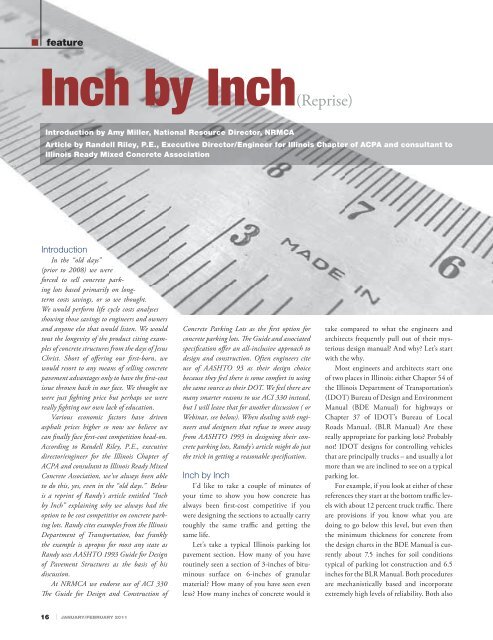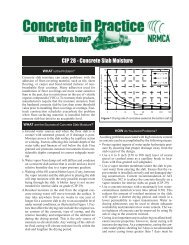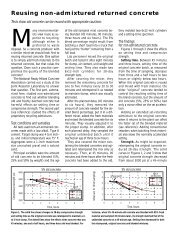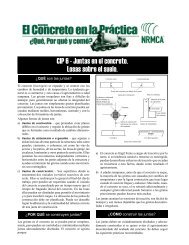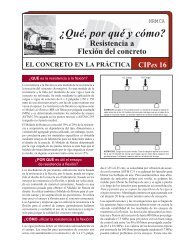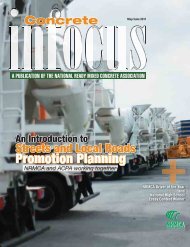featureInch by Inch(Reprise)Introduction by Amy Miller, <strong>National</strong> Resource Director, <strong>NRMCA</strong>Article by Randell Riley, P.E., Executive Director/Engineer for Illinois Chapter of ACPA and consultant toIllinois <strong>Ready</strong> <strong>Mixed</strong> <strong>Concrete</strong> <strong>Association</strong>IntroductionIn the “old days”(prior to 2008) we wereforced to sell concrete parkinglots based primarily on longtermcosts savings, or so we thought.We would perform life cycle costs analysesshowing those savings to engineers and ownersand anyone else that would listen. We wouldtout the longevity of the product citing examplesof concrete structures from the days of JesusChrist. Short of off ering our fi rst-born, wewould resort to any means of selling concretepavement advantages only to have the fi rst-costissue thrown back in our face. We thought wewere just fi ghting price but perhaps we werereally fi ghting our own lack of education.Various economic factors have drivenasphalt prices higher so now we believe wecan fi nally face fi rst-cost competition head-on.According to Randell Riley, P.E., executivedirector/engineer for the Illinois Chapter ofACPA and consultant to Illinois <strong>Ready</strong> <strong>Mixed</strong><strong>Concrete</strong> <strong>Association</strong>, we’ve always been ableto do this, yes, even in the “old days.” Belowis a reprint of Randy’s article entitled “Inchby Inch” explaining why we always had theoption to be cost competitive on concrete parkinglots. Randy cites examples from the IllinoisDepartment of Transportation, but franklythe example is apropos for most any state asRandy uses AASHTO 1993 Guide for Designof Pavement Structures as the basis of hisdiscussion.At <strong>NRMCA</strong> we endorse use of ACI 330The Guide for Design and Construction of<strong>Concrete</strong> Parking Lots as the fi rst option forconcrete parking lots. The Guide and associatedspecifi cation off er an all-inclusive approach todesign and construction. Often engineers citeuse of AASHTO 93 as their design choicebecause they feel there is some comfort in usingthe same source as their DOT. We feel there aremany smarter reasons to use ACI 330 instead,but I will leave that for another discussion ( orWebinar, see below). When dealing with engineersand designers that refuse to move awayfrom AASHTO 1993 in designing their concreteparking lots, Randy’s article might do justthe trick in getting a reasonable specifi cation.Inch by InchI’d like to take a couple of minutes ofyour time to show you how concrete hasalways been fi rst-cost competitive if youwere designing the sections to actually carryroughly the same traffic and getting thesame life.Let’s take a typical Illinois parking lotpavement section. How many of you haveroutinely seen a section of 3-inches of bituminoussurface on 6-inches of granularmaterial? How many of you have seen evenless? How many inches of concrete would ittake compared to what the engineers andarchitects frequently pull out of their mysteriousdesign manual? And why? Let’s startwith the why.Most engineers and architects start oneof two places in Illinois: either Chapter 54 ofthe Illinois Department of Transportation’s(IDOT) Bureau of Design and EnvironmentManual (BDE Manual) for highways orChapter 37 of IDOT’s Bureau of LocalRoads Manual. (BLR Manual) Are thesereally appropriate for parking lots? Probablynot! IDOT designs for controlling vehiclesthat are principally trucks – and usually a lotmore than we are inclined to see on a typicalparking lot.For example, if you look at either of thesereferences they start at the bottom traffic levelswith about 12 percent truck traffic. Thereare provisions if you know what you aredoing to go below this level, but even thenthe minimum thickness for concrete fromthe design charts in the BDE Manual is currentlyabout 7.5 inches for soil conditionstypical of parking lot construction and 6.5inches for the BLR Manual. Both proceduresare mechanistically based and incorporateextremely high levels of reliability. Both also16 ı JANUARY/FEBRUARY 2011
2CHART 2 ASPHALT BASESUBBASE2,000 2,000LANE 16,000LANE 21”0” 3” 6”0” 4” 0” 4” 0” 4”52 80 552 2.5 2.8 3.22 2 70 73 106 5702,0002,0006,000LANE 1LANE 2SURFACE2½”0” 3” 6”PLAIN REINFORCED PLAIN REINFORCED PLAIN REINFORCED4.3 4.2 4.4 4.2 4.4 4.4555469 2.2 8403.13.80.0SERVICEABILITY INDEXAT END OF TEST000LOAD APPLICATIONSTO FAILURE (1,000’S)ALL SECTIONSIN SECOND ROWARE REPLICATESASPHALT SURFACE THICKNESS2”3”645743.01041.7873.31063.82502.41203.87103.55823.31.83.82.73.43.53.72.53.63.13.63.23.32.63.93.60.0SERVICEABILITY INDEXAT END OF TEST000LOAD APPLICATIONSTO FAILURE (1,000’S)LOOP2ALL SECTIONSIN SECOND ROWARE REPLICATESCONCRETECONCRETE THICKNESS3½”5”4.2 4.4 4.0 4.1 4.2 4.53.7 4.1 4.0 4.1 4.0 4.64.54.24.1 4.3 3.9 4.6 4.1 4.34.1 4.5 4.1 4.6 4.0 4.33.53.6imply that granular sub-base is “optional”at traffic levels typical of parking lots, butexplain “optional” to most engineers and theword “required” seems to take its place.What about the asphalt designs? Whatare the minimums there? The BLR Manualsays 3 inches on 8 inches of stone is adequate.So how do you actually compare these competingsections? Clearly, IDOT methods arenot the answer!There are a number of competing designsystems for concrete pavement in this designniche. Many of you are familiar with the<strong>Concrete</strong> Pavement Analyst (CPA) softwareavailable from <strong>National</strong> <strong>Ready</strong> <strong>Mixed</strong><strong>Concrete</strong> Pavement <strong>Association</strong>. It hasbeen discussed on several occasions at theIRMCA annual short course and seminarshave been conducted on its use by your association.CPA is largely based on a variationof the results of the road test conducted bythe American <strong>Association</strong> of State HighwayOfficials (AASHO). I will not go into detailhere, but CPA uses a variation on the structuralcoefficient approach to assign a structuralcoefficient to concrete.However, since the AASHO Road Testwas conducted right here in Illinois, whynot use the data, the methods and the equationslaid out in the 1993 Guide for Designof Pavement Structures? If it is meaningfulanywhere, it should be here in Illinois.First, a little history. The engineers at theRoad Test conducted testing on sections ofboth asphalt and concrete pavements underthe same traffic loadings at the test site westof Ottawa, IL. Interestingly, some of thesesections included loadings restricted to automobilesand light trucks; loads more typicalof convenience store and mall parkinglots. The concrete thicknesses on these sectionsranged from 2.5 inches of concrete upto 5 inches. How did they fare? One of mypersonal favorites, an out of print publication,Pavement Performance in the <strong>National</strong>Road Test, produced by Portland Cement<strong>Association</strong> in 1962 offers some insight. (Ihave a pdf if you are interested.)The tables above demonstrate how thepavement sections performed. The tables area little busy, but they are jampacked withexciting information for pavement geeksinterested in promoting concrete pavementsfor parking lot applications.During the Road Test vehicles ran overthe traffic loops until the loops had receivedroughly 1,114,000 axle load repetitions orthe pavement section had failed. Periodically,engineers at the Test Road would evaluatethe “serviceability” of the sections on a5-point scale, five being a smooth pavementin new condition and 1.5 having been determinedto be failure of a section in need ofserious repair. The vehicles ran in adjacentlanes restricting the specific loads to thoselanes. In our table you will see that one laneoperated with 2,000 lb. axle loads; the otherwith 6,000 lb. axle loads. By conducting thetest in this manner is was possible to compareperformance of different loads to oneanother while simultaneously evaluating theaffect of those loads on different pavementsections. The asphalt and concrete pavementsof different sections received identicalloadings under identical traffic for roughlytwo years.The tables as laid out depict the serviceabilityafter 1M plus axle loads shown as agrade ranging from 1.7 to 4.4. If the sectionfailed, i.e. reached a serviceability of 1.5, thenumber of axle-load repetitions in thousandsis shown. In addition, various subbasethicknesses were evaluated for both asphaltand concrete. For concrete sections meshreinforcementwas also evaluated as thatwas popular at the time of the test. (Meshreinforcement turned out to not make a difference,but that is perhaps an article foranother time. Needless to say, we no longeruse mesh in Illinois.)Let’s work left to right for the concretesection of Loop 2 and the 2½-inch concretepavements. Yes, they tested them that thin.Serviceability of the pavement sections for2,000 lb. axle loads similar to that of anautomobile were in very good condition, i.e.serviceability greater than 4.0 after 1M plusrepetitions. This was regardless of whetherCONCRETE in focus ı 17


